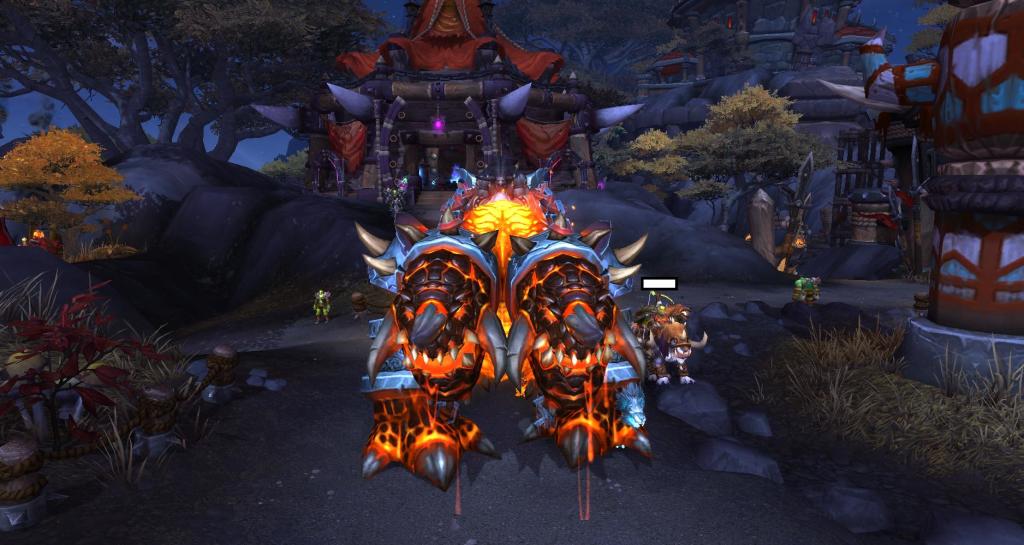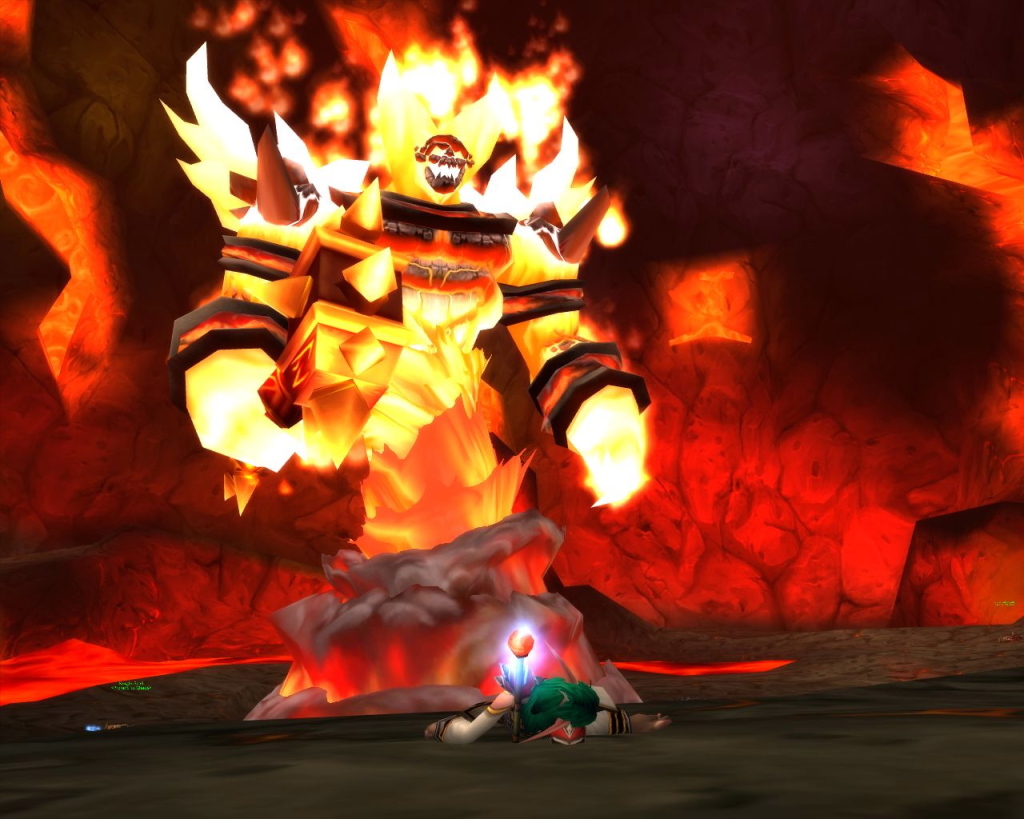18 “Do not call to mind the former things,
Or ponder things of the past.
19 “Behold, I will do something new,
Now it will spring forth;
Will you not be aware of it?
I will even make a roadway in the wilderness,
Rivers in the desert.Isaiah 43
Life often presents us with the constant temptation to view our past with rose-colored glasses. Yes, everything was, indeed, perfect then, because such a time encapsulates a particular emotion or feeling. Sometimes, when brought into the limelight of the modern day, such attachments fall short. It is then that we take the good with the bad, the nostalgia with the grossly overly clingy attachment. That does not mean we reject it, but embrace it while not sugar-coating it. We can look forward while looking backwards, even if human anatomy will not allow it.
This goes for World of WarCraft raiding as much as anything else. The Molten Core, for many, remains one of the most iconic pieces of content in Blizzard’s World of WarCraft. As the beginning of epic, multi-boss 40 man raiding (preceded only by Onyxia, World of WarCraft’s first raid boss), it created an intensely difficult cooperate challenge require many, many strangers to group together. Within the hallowed Core, ten bosses stood ready and waiting, along with dozens and dozens of minions who could kill your party in a blink. Defeating said challenges required hours and hours of effort, but the payoff became sublime in both intangible pleasures and in-game loot. And hey, you basically needed to do Molten Core to get further into the end-game content, right?
As a person who actually raided Molten Core (around 2006, but content lasted much longer back then), I can tell you the feeling of going into that giant rock cave felt quite overwhelming. It’s exactly the sort of thing you’d see in a fantasy war movie, with thousands of things happening at once and a giant group effort even as people dropped dead or failed to do what they needed to do. Winning by the skin of your teeth – just barely enough strength to hit that marker – felt wonderful, and still does. World of WarCraft’s ten year anniversary means many others can finally see what endeared World of WarCraft to so many.
Except, World of WarCraft isn’t the same game; it’s gotten substantially more interesting, complex, nuanced, and fun. Molten Core as of 2014, I say with the utmost adoration for 40-man raiding, is not fun. Coordinating 40 people you know took enough effort by itself with voice chat, but 40 random strangers? That’s just a recipe for disaster! Impatience and random pulls usually win the day, along with the occasional troll who wants everyone to die repeatedly. Thankfully, they restrict any rewards to actual completion of the instance – just an achievement, a helmet (not bad at this point of raid content), and a Core Hound Mount. DO YOU WANT A CORE HOUND MOUNT?!

As such, I set my time apart and decided to dive back into the Molten Core, at least for the unbelievably sweet fire dog that I can ride. After a while, people get serious since they don’t want to wipe for 4 hours, and things get efficient. I ended up doing most of the pulls at the latter half of the instance, and that kept frustration to a minimum. You really got a sense of the scale, even now, that modern World of WarCraft raids can sometimes fail to deliver with all the different difficulty levels and group sizes.
On the other hand, as far as the design goes, Blizzard has far and away improved raid content so much as to make Molten Core positively ancient by comparison. Every fight and trash pull consists of getting tanks in position, facing enemies away from the raid, and letting the twenty-eight DPS do their thing. Compared to Warlords of Draenor’s five man dungeons, complex configurations of movement and precise role fulfillment, Molten Core does tank’n’spank in the most simple, boring way possible. You get slight nuances here and there, such as Baron Geddon’s Living Bomb ability, but that just emphasizes another World of WarCraft standard – don’t stand in bad things, or stand next to people with bad things.
As the progenitor of such mechanics, this makes sense. What you can’t forgive, though, is both the number of trash pulls between bosses, the gargantuan size of the instance, and some of the dumb abilities enemies use on you. As a tank, getting stunned repeatedly for 6 seconds does not amuse me; I can’t avoid it or do much, so it’s pretty boring to die and not be able to prevent it! Also sorry, you were a mile away so the whole instance will kill everyone now, too bad! The length of the whole instance just wears on you after a while. World of WarCraft’s early content comes down to a giant endurance test more than a fun-filled interesting time. Frankly, the designers didn’t know what they were doing, and it shows how much they’ve improved since then. The Molten Core, in sum, is boring. Very, very boring. Other people make it fun, not the game itself.
Now, I really don’t want to trample on nostalgia or anything – that’s why Blizzard let us play it, after all – but I think we can criticize it while still seeing it as a neat window into the past. Nostalgia shouldn’t prevent us from seeing something objectively, and while Molten Core stays within the hearts and minds of old raiders like myself, an honest answer admits that it lacks many accouterments we now enjoy in World of WarCraft. When I hear people say “Vanilla WoW was best!”, though, I can’t help but sigh. Of course, now people can play it and judge for themselves, and I believer they’ll judge that nobody wants to go to a big bland cave with a bunch of fire monsters in it, versus the inventive content we see now. Things got better; we got better, and the game (plus its design team) responded accordingly.

Like good game design, I like to think that Christians embrace their past, but also move towards the future. It is a life of continual improvement that does not allow us to cling to our past sins, reliving private pity parties while we reminisce about how bad we were. That cognitive dissonance does not help; it only hinders us. Elaborately speaking, we press on towards the goal of being Christ-like. We improve. We do not stagnate. Nostalgia isn’t bad, but to continue living in it will only hurt. Paul speaks of this in Philippians 3:
8 More than that, I count all things to be loss [c]in view of the surpassing value of[d]knowing Christ Jesus my Lord, [e]for whom I have suffered the loss of all things, and count them but rubbish so that I may gain Christ, 9 and may be found in Him, not havinga righteousness of my own derived from the Law, but that which is through faith in Christ,the righteousness which comes from God on the basis of faith, 10 that I may know Him and the power of His resurrection and [f]the fellowship of His sufferings, being conformed to His death; 11 [g]in order that I may attain to the resurrection from the dead.
12 Not that I have already obtained it or have already become perfect, but I press on [h]so that I may lay hold of that [i]for which also I was laid hold of by Christ Jesus. 13 Brethren, I do not regard myself as having laid hold of it yet; but one thing I do: forgetting what lies behind and reaching forward to what lies ahead, 14 I press on toward the goal for the prize of the upward call of God in Christ Jesus. 15 Let us therefore, as many as are[j]perfect, have this attitude; and if in anything you have a different attitude, God will reveal that also to you; 16 however, let us keep [k]living by that same standard to which we have attained.
Live with an attitude toward the future! Paul takes an eschatological view precisely because of the future hope in Christ. It is a matter of perspective. The Old Testament is not abandoned, and the New Testament enhances our understanding. The older church relied on one consistent theology, and now we have a giant diversity of different thoughts. This would not happen without that future hope, and that’s why we must “forget” the past while forging ahead towards a brighter age.
